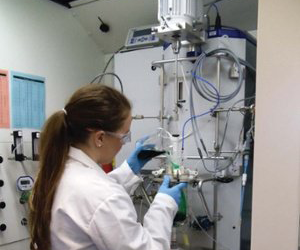
Thermal hazards reaction and adiabatic calorimetry testing
Mike Edwards
Features Mettler Toledo Engineer running a test on the Mettler Toledo RC1 reaction calorimeter.
Engineer running a test on the Mettler Toledo RC1 reaction calorimeter. Thermal stability (or thermal hazards) testing collects reaction rate data and applies that data to assess whether a specified quantity of material can be used in a way such that runaway reactions are avoided. This is important when considering processing, long-term storage, or shipping of a material.
A comprehensive lab uses many tools to understand and eliminate undesired reactions, accommodate process upset scenarios and design a client’s desired process chemistry.
Do you recognize the importance of these in your thermal stability testing?
- Safe Scale-up
- Reaction Rates
- Heat of Reaction
- Heat of Mixing
- Heat of Dissolution
- Adiabatic Temperature Rise
- Heat Capacity of Reaction Mass
- Heat Flow and Adiabatic Calorimetry
- Low-phi Factor (directly scalable) adiabatic calorimetry
- UN Transport Testing
- Practical Emergency
- Vent Sizing (PrEVentTM)
- Software
Reaction calorimetry testing and consulting services are designed to help you better understand your desired process chemistry.
One of the keys to safely scaling up a chemical process is managing the energy or heat flux that the intended chemical reaction produces, especially when that chemical transformation is exothermic in nature.
When considering process scale-up whether the heat is removed via a jacket, a condenser, or a side loop heat exchanger in the plant reactor, or partially allowed to heat up the mass, it is imperative to balance the cooling capacity at scale versus the projected heat flux rate and understand the total energy available due to the desired reaction should that cooling fail.
The accepted technique for gathering this type of data in the industry is known as reaction calorimetry.
There have been many instruments developed over the years to accomplish this task and Fauske & Associates, LLC (FAI) maintains a variety of devices so that we can design the most appropriate experiment to gather the vital heat rate and adiabatic potential data needed for a safe scale up.
Couple this with our vast experience in characterizing runaway reaction behaviour using adiabatic and vent sizing calorimetry and we can deliver you a complete picture of a safe chemical process.
Print this page